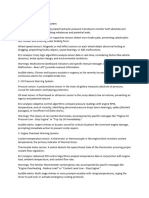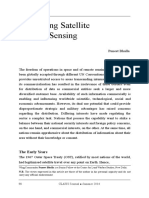Unit IV: Cloud Collaborative Applications and Services
1. What are cloud collaborative applications? Give examples.
Cloud collaborative applications enable multiple users to work together on projects, share resources, and
collaborate in real-time via the internet, without needing to install or manage software locally. These
applications are hosted on cloud platforms and offer functionality such as document sharing, real-time
communication, task management, and collaborative editing.
Examples of Cloud Collaborative Applications:
Google Workspace (formerly G Suite): Includes tools like Google Docs, Sheets, Slides, and Google
Drive for document collaboration and storage.
Microsoft 365: Includes Microsoft Word, Excel, PowerPoint, and OneDrive, enabling real-time
collaboration on documents, spreadsheets, and presentations.
Slack: A messaging platform that integrates with other tools and allows teams to communicate, share
files, and collaborate on projects.
Trello: A task management and collaboration tool where teams can manage projects, assign tasks, and
track progress using boards and lists.
These applications provide seamless collaboration, as all team members can access, edit, and share content in
real time, regardless of location.
2. How do cloud services help in project management?
Cloud services greatly enhance project management by providing tools for organizing, tracking, and managing
tasks and resources in real-time. Key ways they help include:
Real-Time Collaboration: Team members can work on the same document, task, or project
simultaneously, ensuring that everyone is on the same page.
Task Assignment and Tracking: Cloud-based project management tools allow project managers to
assign tasks, set deadlines, and track progress. Tools like Asana, Trello, and Monday.com make
project monitoring easier.
Centralized Resource Management: Cloud services enable the centralized management of resources,
such as documents, files, and databases, making it easy to share and access materials.
Cloud-Based Communication: Tools like Slack and Microsoft Teams improve communication
between project stakeholders, whether through chat, video calls, or file sharing.
Scalability: As the project grows, cloud services can scale in terms of storage, collaboration tools, and
user access without any infrastructure concerns.
Data Security and Backup: Project data is securely stored in the cloud, often with backup capabilities,
reducing the risk of data loss.
By using cloud services, teams can improve efficiency, reduce delays, and enhance communication during
project execution.
3. Explain the role of calendars, schedulers, and event management in cloud applications.
Calendars, schedulers, and event management are essential features in cloud applications, especially for
business and team productivity. Here's how they help:
� Calendars: Cloud-based calendars (e.g., Google Calendar, Outlook Calendar) help users organize
their schedule, set up reminders, and share events with others. They can sync across devices, allowing
team members to stay aligned and aware of upcoming deadlines or meetings.
o Features:
Set up recurring meetings, appointments, and events.
Sync schedules across teams and devices.
Share calendars for visibility and collaboration.
Schedulers: Scheduling tools in cloud applications enable users to automate the process of setting up
meetings, appointments, or tasks. Calendly is a popular example, where users can share their
availability and let others book appointments directly.
o Features:
Automate scheduling by allowing others to book times.
Sync availability with external calendars.
Reduce the back-and-forth communication needed for scheduling.
Event Management: Cloud-based event management tools like Eventbrite or Cvent help organize
events by handling tasks such as registration, ticketing, attendee management, and logistics.
o Features:
Plan and manage events (e.g., conferences, webinars).
Track attendee registrations and send reminders.
Handle payments and invoicing for ticketed events.
These tools streamline workflows, improve productivity, and enhance team collaboration by centralizing and
simplifying scheduling and event management.
4. Discuss various Amazon Web Services (AWS) and their applications.
Amazon Web Services (AWS) is a comprehensive cloud platform offering a wide range of cloud computing
services. Some of the core AWS services and their applications include:
Amazon EC2 (Elastic Compute Cloud): Provides scalable compute capacity in the cloud. It allows
users to rent virtual servers to run applications. Use cases include web hosting, machine learning
models, and enterprise applications.
Amazon S3 (Simple Storage Service): A scalable object storage service for storing and retrieving
data. It's widely used for backup, archival, big data analytics, and media hosting.
AWS Lambda: A serverless compute service that allows you to run code without provisioning servers.
Commonly used for event-driven applications and microservices architecture.
Amazon RDS (Relational Database Service): Managed relational databases like MySQL,
PostgreSQL, SQL Server, and MariaDB. It’s used for web applications, business applications, and data-
driven solutions.
Amazon VPC (Virtual Private Cloud): A service to create isolated network environments within the
AWS cloud, enabling secure access to resources. Used for setting up private subnets, VPNs, and
securing data.
� Amazon CloudFront: A content delivery network (CDN) that speeds up the distribution of static and
dynamic content globally. It's used for streaming media, website acceleration, and serving content to
users worldwide.
Amazon DynamoDB: A managed NoSQL database for applications requiring low-latency data access.
Commonly used for real-time applications like gaming, mobile apps, and IoT.
AWS IAM (Identity and Access Management): Manages users, groups, and permissions to AWS
resources. It’s used for controlling who can access cloud resources and what actions they can perform.
5. What are AWS EC2? Explain its use cases.
Amazon EC2 (Elastic Compute Cloud) is a web service that provides resizable compute capacity in the cloud.
It allows you to launch virtual servers (instances) with a variety of operating systems, configurations, and
software environments.
Use Cases of AWS EC2:
Web Hosting: Hosting websites and web applications with scalable compute power.
Big Data Analytics: Running big data processing workloads like MapReduce or Hadoop clusters.
Batch Processing: Running background processing jobs (e.g., rendering, simulations) in parallel across
multiple EC2 instances.
Machine Learning: Training and running machine learning models with scalable compute resources.
Dev/Test Environments: Setting up isolated environments for testing applications, debugging code, or
experimenting with different configurations.
Containerized Applications: Running Docker containers using Amazon ECS or EKS (Elastic
Kubernetes Service).
6. Describe the working and benefits of AWS S3.
Amazon S3 (Simple Storage Service) is an object storage service designed to store and retrieve any amount of
data. It allows users to upload and access files over the web, and it is scalable, durable, and cost-effective.
Working of AWS S3:
Users upload files (objects) into buckets (containers for storing objects).
Data is replicated across multiple data centers to ensure durability.
Users access files via HTTP or HTTPS using unique URLs or API calls.
AWS S3 supports various features like versioning, encryption, and access control.
Benefits:
Scalability: It can store an unlimited amount of data, from small files to petabytes.
Durability: Amazon S3 offers 99.999999999% durability by replicating data across multiple locations.
Security: Supports encryption at rest and in transit, along with robust access control mechanisms.
Cost-Effective: It uses a pay-as-you-go pricing model, allowing you to pay only for the storage you
use.
Performance: Optimized for low-latency and high-throughput access, making it ideal for large-scale
applications.
�7. What are Cloud Analytics? How is it used in cloud computing?
Cloud Analytics refers to the use of cloud computing resources to perform data analysis and derive insights
from large datasets. Cloud-based analytics platforms provide powerful tools for data storage, processing, and
visualization without requiring on-premise infrastructure.
Uses of Cloud Analytics in Cloud Computing:
Big Data Processing: Cloud platforms (e.g., AWS Big Data Services, Google BigQuery) allow you to
process massive datasets using tools like Hadoop or Spark.
Data Warehousing: Storing large datasets in cloud data warehouses (e.g., Amazon Redshift, Google
BigQuery) and running complex queries for analysis.
Real-Time Analytics: Analyzing streaming data in real-time for use cases like monitoring sensor data
or tracking website activity.
Machine Learning: Cloud analytics services often integrate with machine learning tools (e.g., Amazon
SageMaker) to analyze data and generate predictive models.
8. Explain OpenStack and its applications in cloud computing.
OpenStack is an open-source platform for building and managing private and public clouds. It provides a set of
software tools for managing compute, storage, and networking resources in a cloud environment.
Applications of OpenStack:
Private Cloud: Organizations use OpenStack to build their own private clouds, providing flexible and
scalable infrastructure.
Hybrid Cloud: OpenStack is used to create hybrid clouds by integrating with public cloud platforms.
Infrastructure Management: It provides tools for managing virtual machines, storage volumes, and
networking configurations.
Cloud Service Providers: Many cloud service providers (e.g., Rackspace) use OpenStack as the
foundation for their cloud offerings.
Components of OpenStack:
Nova: Manages compute resources.
Cinder: Manages block storage.
Neutron: Handles networking services.
Swift: Object storage system.
Horizon: Dashboard for managing OpenStack services.
9. What are the advantages of using AWS over traditional hosting solutions?
Scalability: AWS offers elastic scaling, so you can increase or decrease resources based on demand,
unlike traditional hosting where resources are fixed.
Pay-As-You-Go: AWS uses a pay-per-use pricing model, allowing businesses to pay only for the
resources they use, unlike traditional hosting where you pay for a set amount of resources.
� Global Reach: AWS has data centers around the world, providing low-latency access and disaster
recovery solutions.
High Availability and Durability: AWS provides built-in redundancy and fault tolerance, ensuring
your applications remain available, whereas traditional hosting may lack this level of reliability.
Security: AWS offers enhanced security measures like encryption, IAM (Identity and Access
Management), and security groups, which may be harder to implement with traditional hosting.
10. How do cloud-based collaborative tools improve team productivity?
Cloud-based collaborative tools improve team productivity by enabling seamless communication, real-time
collaboration, and easier management of tasks and projects. Here's how:
Real-Time Collaboration: Tools like Google Docs and Microsoft 365 allow team members to
collaborate simultaneously on documents, reducing the need for back-and-forth emails.
Centralized Communication: Platforms like Slack and Microsoft Teams consolidate communication,
reducing time spent on email and enabling direct messaging, voice calls, and video conferencing.
Task and Project Management: Tools like Trello, Asana, and Basecamp help track tasks, assign
responsibilities, set deadlines, and monitor progress, improving organizational efficiency.
Cloud File Sharing: Services like Dropbox and Google Drive allow easy sharing and access to files,
ensuring team members have the latest versions of documents.
Remote Work Enablement: Cloud tools support remote work by making collaboration and
communication accessible from anywhere with an internet connection.




















































































